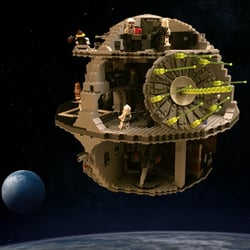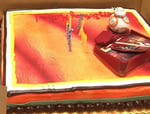 * **
* **
SilcoTek® coatings are utilized for a multitude of applications in space, ranging from propulsion to analytical. The ever increasing utilization of space for communications, national defense and research and the future use of space for manufacturing will increase the demand for inert, high durability, temperature resistant and oxidation resistant coatings like Dursan®, SilcoNert®, and Silcolloy®.

We asked our General Counsel and Chief Intellectual Property Counsel, Geoff White, to lend us his views on protecting intellectual property in space. Since the latest Star Wars movie is showing in theaters, we decided to spice things up a bit and ask the ultimate question:
Would the Death Star be covered by Patents?
Here's Geoff's take on the question.
 In anticipation of my son’s birthday party to go see "Rogue One", I wondered, whether the Death Star would be covered by US patents. Although you definitely should consult your own attorney before relying upon this information to determine whether you can make the Death Star, I looked into the issue.
In anticipation of my son’s birthday party to go see "Rogue One", I wondered, whether the Death Star would be covered by US patents. Although you definitely should consult your own attorney before relying upon this information to determine whether you can make the Death Star, I looked into the issue.
Patents in the US exclude others from making, selling, offering for sale, or importing that which is covered by the claims. But what about outer space? Apparently the World Intellectual Property Organization has previously identified issues with patent coverage in space (they did not address the Death Star specifically). As a result of the findings, the UN-enacted the Convention on Registration of Objects Launched into Outer Space in 1976 which would impact making the Death Star (interesting timing, considering that Star Wars was originally released in 1977 – maybe it isn’t just a movie). US law states that anything launched from or registered by the US or any foreign state within that Convention are covered by US patents.
So, it seems that the production of the Death Star would not be covered by US patents if it is made in space without using anything that is registered by the US or any foreign state within that Convention. However, if it is made in the US or any foreign state within the Convention or it is registered by such states, then it would be covered by US patents. My son’s Lego Death Star is, therefore, within the scope of patent protection.
For those who immediately respond that actually making the Death Star is a problem (like those at the Fox News Science page), remember that US law applies to Conception, which means that the idea must be described in a manner that one skilled in the art could produce the idea. Actual reduction to practice (like creating a prototype) is not a requirement under US law. That said, the duration of the patent would not cover the 830,000 years needed to produce the steel for the Death Star, so the Imperial Position on Enforcing Patents might need to be employed.
Regardless of patent law, I imagine making a Death Star without Darth Vader's permission may make him angry, requiring a not-so-pleasant apology.
Apology accepted.
No apology needed when using SilcoTek® coatings! We make custom coatings easy.

* Lego Death Star Courtesy of Matthew White
**Image Courtesy of Geoff White
 * **
* **
 In anticipation of my son’s birthday party to go see "Rogue One", I wondered, whether the Death Star would be covered by US patents. Although you definitely should consult your own attorney before relying upon this information to determine whether you can make the Death Star, I looked into the issue.
In anticipation of my son’s birthday party to go see "Rogue One", I wondered, whether the Death Star would be covered by US patents. Although you definitely should consult your own attorney before relying upon this information to determine whether you can make the Death Star, I looked into the issue.
